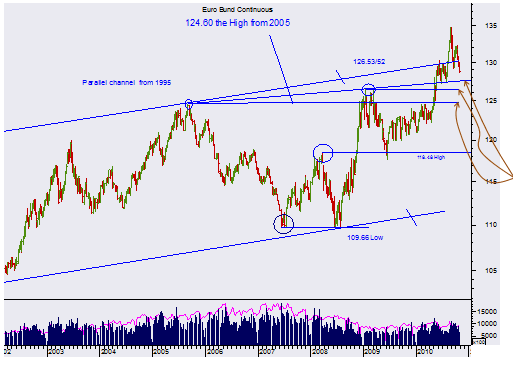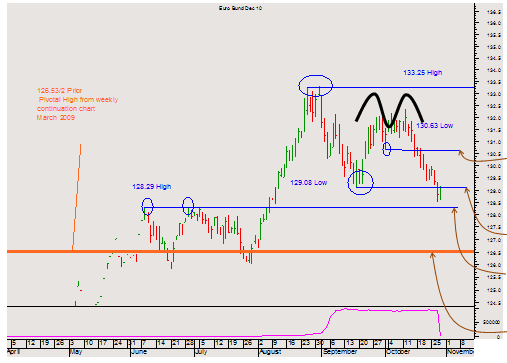Are the German Bund Bulls Finished?
Interest-Rates / International Bond Market Oct 29, 2010 - 04:41 AM GMTBy: Seven_Days_Ahead
 During the Euro zone sovereign debt crisis the Bund was a strong safe-haven trade. This may seem paradoxical given the nature of the crisis: investors were worried about the solvency of several Euro zone governments, but sought shelter from government default in the Euro Bund.
During the Euro zone sovereign debt crisis the Bund was a strong safe-haven trade. This may seem paradoxical given the nature of the crisis: investors were worried about the solvency of several Euro zone governments, but sought shelter from government default in the Euro Bund.
The Technical Trader’s view:
|
WEEKLY CHART The market has drifted back – through the upper diagonal of the bull channel certainly, but only slightly, with good support beneath the market at 127.60 (diagonal) the horizontals at 126.53 and then 124.60. |
|
DAILY CHART This is a chart revealing weakness but not bearishness: certainly the small Double Top formed on the break down through the 130.63 Low gave some impetus to the bears, and the push beneath the Prior Low Pivot at 129.08 may serve to ratchet the market further down, but the support at 128.29 is substantial, and so too is the support from the Prior High at 126.53 from March 2009. The trouble for the bears is that there is no medium-term Top formation in place or in prospect. Bulls will note this, and the supports beneath the market as well and thus they will remain poised for a bull signal – a bull wedge continuation pattern? Or a rather shorter term structure that is yet to develop. In short, we are not bears yet…. |
|
DAILY CHART On the other hand, traders will also notice this chart in the Bobls – German 5yr bonds a little way along the yield curve. That is a clear Double Top, whose completion coincided with the break of the (admittedly weak) rising diagonal support. Note the respectably high volume and open interest on the last two days. Might this not fuel more fresh selling? This is the medium-term Top that the Bund market lacks – and apart from the obvious tilting of the yield curve implied, it suggests the Bund will remain under pressure in the near term |
The Macro Trader’s view:
During the Euro zone sovereign debt crisis the Bund was a strong safe-haven trade. This may seem paradoxical given the nature of the crisis: investors were worried about the solvency of several Euro zone governments, but sought shelter from government default in the Euro Bund.
Why was that?
The Euro Bund is based on the German Bund contract and as the sovereign debt crisis deepened, yield spreads between affected government bonds and German Bunds widened out appreciably. But as the crisis eased the Bund started to lose its safe haven appeal.
At first Bears found stiff resistance from the Bulls as German economic data went through a soft patch, indeed for several weeks it began to look as though the German recovery was going the same way as in the US.
However, over recent weeks German economic data has strengthened, and traders are in no doubt about the role the strong German economy is playing in pulling along the weaker Euro zone and its long peripheral tail.
Now the Bears look on the verge of asserting themselves. Unlike the Fed and possibly the Bank of England, the ECB has never felt the need to flirt with ideas of QE2. Indeed traders are becoming anxious about the ECB’s intentions with the focus shifting towards when the ECB will begin to tighten policy.
While we think that day is still a little distant, the Bund is on the verge of at best a serious correction and perhaps a bear market. One only needs to look at the German Bobl to see where some traders’ current thinking lies.
Ah, you might say, but what about the strength of the Euro, won’t that cool the German economy and give the Bund a fresh lease of life?
While it is always possible a new round of risk aversion could emerge and send government bonds higher, we do not think the Euro will be the undoing of the German economy. Interest rates in Europe are very low: 1.0%. For an economy like Germany’s that is enjoying a strong recovery, interest rates are over-expansionary. Indeed, if the Bundesbank was still in control of German monetary policy we judge rates would already be moving higher.
So given the expansionary impact of Euro zone interest rates we think the German economy will weather the strength of the Euro well. But as the recovery proceeds it will probably be Bond yields that rise and we think we may now be at that point in the Bund.
In the Bobl that milestone has already been passed.
Mark Sturdy
John Lewis
Seven Days Ahead
Be sure to sign up for and receive these articles automatically at Market Updates
Mark Sturdy, John Lewis & Philip Allwright, write exclusively for Seven Days Ahead a regulated financial advisor selling professional-level techni44cal and macro analysis and high-performing trade recommendations with detailed risk control for banks, hedge funds, and expert private investors around the world. Check out our subscriptions.
© 2010 Copyright Seven Days Ahead - All Rights Reserved
Disclaimer: The above is a matter of opinion provided for general information purposes only and is not intended as investment advice. Information and analysis above are derived from sources and utilising methods believed to be reliable, but we cannot accept responsibility for any losses you may incur as a result of this analysis. Individuals should consult with their personal financial advisors.
Seven Days Ahead Archive |
© 2005-2022 http://www.MarketOracle.co.uk - The Market Oracle is a FREE Daily Financial Markets Analysis & Forecasting online publication.






